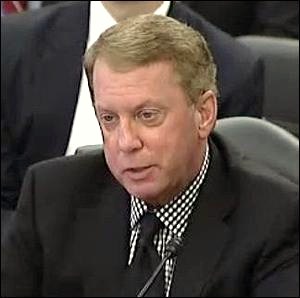By Pam Martens: June 5, 2014

Terrence Duffy of the CME Group Testifying Before the Senate on May 13, 2014, Effectively Telling the Panel That His Exchanges Are As Pure As the Driven Snow
Evidence of ‘clandestine’ documents has turned up which may make it rough-sledding for one of Wall Street’s biggest go-to law firms in the position they staked out last Friday in Federal court.
R. Tamara de Silva, a lawyer representing three traders in a closely watched Federal class action lawsuit in Chicago, told the court in April that the world’s largest futures exchange has “entered into clandestine contracts with HFTs [high frequency traders] knowing that the activities of the HFTs would adversely affect all other individuals and entities…” (See High Frequency Trading Lawsuit Against CME Group, et al for the full text.)
De Silva and lawyers from O’Rourke & Moody in Chicago are facing off against the 1600-lawyer strong Skadden, Arps, Slate, Meagher & Flom, LLP who are known for their splashy motions to dismiss — which come very close to libeling opposing counsel. They did not disappoint in this case.
Last Friday, Skadden Arps told the Federal court on behalf of their clients that the complaint is “reckless,” based on “implausible and unsupported guesswork” and “nearly incomprehensible pleadings that are so poorly constructed as to be functionally illegible.” (Skadden Arps is clearly praying that the Judge in the case, Charles P. Kocoras, has not read Flash Boys, the new Michael Lewis book that details a massive conspiracy involving high frequency traders in U.S. markets.)
As for the purported “clandestine contracts,” Skadden Arps had this to say to the court:
“The centerpiece allegation — that the Defendants entered into ‘clandestine contracts’ with undefined ‘high frequency traders’ or ‘HFTs’ to secretly provide them data to the detriment of other market participants — appears from thin air with no hint as to the factual basis to make such a dangerous assertion in a federal lawsuit. Indeed, while claiming that the whole ‘scheme’ has been fraudulently concealed from the world for the prior seven years, Plaintiffs offer no clue about what facts they recently discovered, or how they discovered them, that now cause them to level such serious allegations in this action. The whole thing reads like a fishing expedition, driven by nothing more than current pop-culture wordspeak and wild rumor.”
On Tuesday of this week, the Federal regulator of futures exchanges in the United States, the Commodity Futures Trading Commission (CFTC), held a public meeting where it was revealed that the futures exchanges had increased ‘incentive’ programs from 56 to 340 programs. Some of these incentive programs involve the payment of cash to high frequency traders.
Wall Street On Parade went to the web site of the CFTC to read the details of these incentive programs that have been filed with the CFTC for many years. What we found instead was the multi-year use of a rubber stamp with the words “Confidential Treatment Requested.”
Over and over and over again, for years, instead of details of these 340 incentive programs, we found (wait for it)…clandestine contracts so secret that they needed to be protected from Freedom of Information Act requests, from the snooping eyes of Congress or subpoena power. If outside requests were made to the CFTC for the documents, the exchanges asked their Federal regulator to become their inside tipster and give them a heads up.
Filed repeatedly on behalf of both the Chicago Mercantile Exchange (CME) and the New York Mercantile Exchange (NYMEX) was the following language: (See CME Group Makes Repeated Requests to Its Federal Regulator to Keep Its Secrets, Uh, Secret)
“…the Exchange requests that confidential treatment be maintained for Appendix A and Exhibit A until further notice from the Exchange. We also request that the Commission notify the undersigned immediately after receiving any FOIA request for said Appendix A or Exhibit A or any other court order, subpoena or summons for same. Finally, we request that we be notified in the event the Commission intends to disclose such Appendix A or Exhibit A to Congress or to any other governmental agency or unit pursuant to Section 8 of the CEA. The Exchange does not waive its notification rights under Section 8(f) of the CEA with respect to any subpoena or summons for such Appendix A or Exhibit A.”
The letters are signed by Christopher Bowen, a Managing Director and Regulatory Counsel at the Chicago futures exchanges’ parent, the CME Group.

